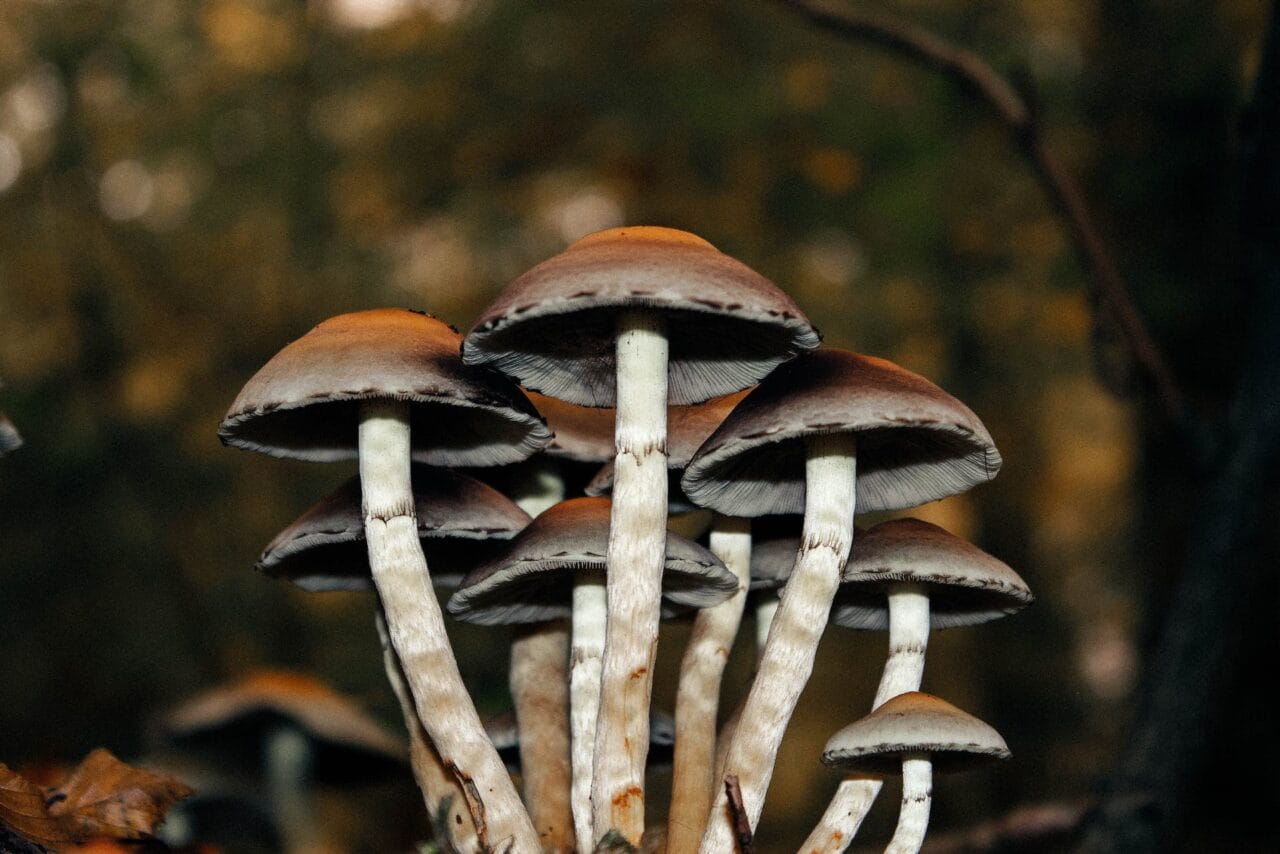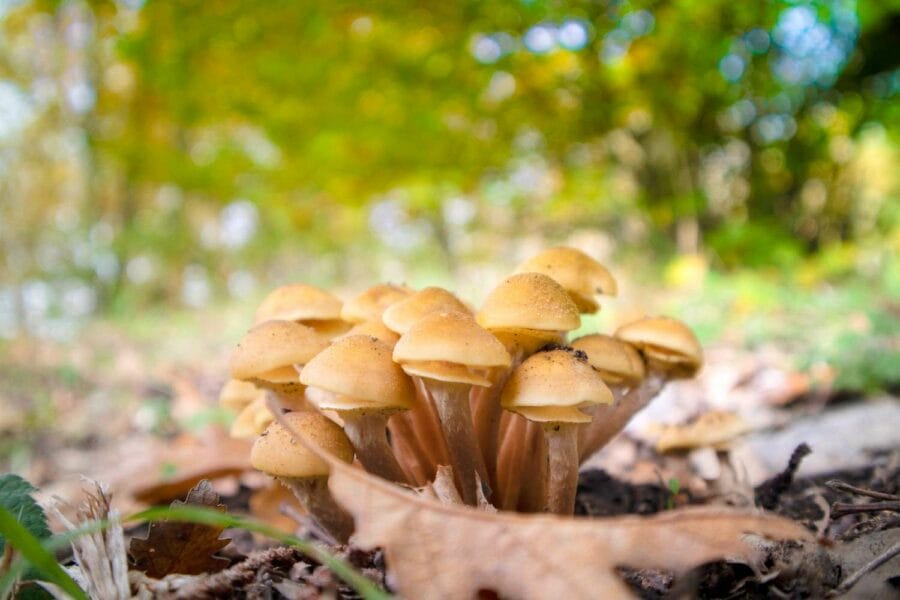Psilocybin, a psychoactive compound present in magic mushrooms, is typically used for recreational purposes, inducing feelings of euphoria and hallucinations.
Beyond its mind-altering effects, research has been conducted on the compound’s potential benefits for relieving chronic pain.
In this article, we discuss a case study that examines the potential of microdosing mushrooms in managing chronic pain.
Key Takeaways:
- Microdosing mushrooms may provide both immediate and sustained pain relief.
- When consumed in small quantities, psilocybin microdosing generally has fewer side effects than traditional pain medications.
- Psilocybin engages with the serotonin 2A (5-HT2A) receptors, which plays a role in alleviating pain, among other conditions.

Study Details
Dr. Matthew Lyes and his team from the Division of Pain Medicine in the Department of Anesthesiology at the University of California, San Diego, conducted the study titled “Microdosing Psilocybin for Chronic Pain: A Case Series“. Their research focused on three patients who self-administered small doses of psilocybin to manage their chronic pain symptoms.
Three Patients, One Common Result – Chronic Pain Reduction
Patient # 1
| AGE/ GENDER: | 37 Male |
| PAIN TYPE: | Neuropathic pain occurring below the site of a spinal cord injury. |
| PAIN INTENSITY: | Initially 4 to 5/ 10, increasing to 8/ 10 later in the day |
| PSILOCYBIN DOSE: | 250 mg of ground mushroom for less than 6 months |
| OUTCOME: | Discontinued use of prescribed pain medication, reduced muscle spasms, and improved bowel movement efficiency. No signs of rebound pain or withdrawal symptoms. |
| The patient reported that while his regular medications merely lessened the pain, psilocybin effectively eliminated it, decreasing his average pain level from 5 to 0. | |
Case Study: Subject #2
| AGE/ GENDER: | 69-year-old Female |
| TYPE OF PAIN: | Complex Regional Pain Syndrome (CRPS) |
| INTENSITY OF PAIN: | Typically ranges from 5 to 7 out of 10, but increases with activity and during episodes of pain exacerbation |
| PSILOCYBIN DOSAGE: | Daily dose of 500 mg for 7 to 10 days with breaks of 2 to 3 days over a year. Dosage ascends to 750 mg to 1 gram during pain exacerbation |
| IMPACT: | Pain reduction of 80% for 3-4 hours, gradually reverting to original levels after 12 hours. Complete pain relief (90%-100%) persists for 6-8 hours, reverting to original levels after 18 hours. |
| The subject reports a decrease in appetite without the presence of nausea. An increase in disorientation or unstable walking is observed when the dosage is escalated (750 to 1000mg). | |
Case Study: Subject # 3
| AGE/ GENDER: | 40-year-old Female |
| TYPE OF PAIN: | Lumbar radiculopathy and neuropathic pain |
| INTENSITY OF PAIN: | 8 out of 10, escalating to 10 out of 10 during physical activities |
| PSILOCYBIN DOSAGE: | 1000 mg from a mushroom chocolate bar every two months. |
| IMPACT: | Significant pain relief without any psychoactive effects. Remarkable increase in flexibility and functionality. Pain gradually reverts to initial levels over 2-4 weeks. Repeated dosing enhances pain control. |
| The subject does not report any noticeable physical, cognitive, or behavioural side effects. Her mood remains predominantly stable. She maintains her usual dosage of her SSRI for depression management throughout the psilocybin treatment period. | |
Unraveling Pain Management with Psilocybin
Persistent somatic and visceral pain signals strengthen specific neural pathways due to peripheral and central sensitization, resulting in the chronic experience of pain on both physical and emotional levels. Psychedelics like psilocybin stimulate 5-HT2A receptors, possibly rebooting the brain areas linked with neuropathic conditions.
A patient reported experiencing prolonged pain relief for weeks. This suggests that after directly stimulating the 5-HT2A receptors, there may be a central regulation of pain perception and adaptability in the synapses.
Possible Side Effects of Psilocybin: A Comparison with Traditional Pain Medications
| PSILOCYBIN (Research-Based) | TRADITIONAL PAIN MEDICATIONS |
| Muscle spasms | Nausea |
| Decreased appetite | Abdominal discomfort |
| Confusion | Migraines |
| Unsteady gait | Addiction risk |
| No change in mood | Drowsiness |
Potential Areas for Future Psilocybin Research
Based on the experiences of three individuals, the research team has identified potential areas that could benefit from further investigation.
- Exploring the possibility of immediate and long-term relief from neuropathic pain using small doses of psilocybin, without causing physical tolerance or dependency.
- Examining the potential combined effects of psilocybin with other treatments, such as physical therapy, which in patient #3 resulted in enhanced pain relief.
- Investigating the potential of small doses of psilocybin to provide pain relief, even without psychotherapy, as observed in this study. The integration of therapeutic guidance might boost or extend the therapeutic outcomes.
Limitations of the Current Study
Despite the encouraging results witnessed in the subjects, it’s important to acknowledge the constraints of the study.
- The small sample size might not truly represent the broader population of individuals with neuropathic pain.
- Subjects who did not respond to psilocybin were not included in the study.
- No assessments were conducted before and after treatment to measure the impact of psilocybin on psychiatric conditions like depression and anxiety.
- Most of the data was self-reported by the subjects, which could introduce bias.
- The presence of the interviewer and potential bias linked to psilocybin may have influenced the participants’ responses.
- The study did not account for the potential influence of the placebo effect.
- The study did not establish the concentration of psilocybin in each mushroom.
The Practice of Microdosing Mushrooms
In the study, participants, Patients #1 and #2, consumed a small dose of psilocybin, originating from dehydrated mushrooms, while Patient #3 combined it with chocolate. There exists a variety of products crafted specifically for psilocybin microdosing, and we have gathered a list of some notable ones below.
Dehydrated Mushrooms
Although the study remained silent on the specific strain used, the following strain can serve as an excellent start for novices.
- Golden Teacher: This strain is one of the most prevalent and frequently encountered types of magic mushrooms.
- Amazonian Cubensis: This strain is known for being beginner-friendly and is believed to provide cognitive benefits.
- Cambodian: Microdosing with Cambodian cubensis mushrooms can potentially enhance focus, social awareness, and mood.
Microdose Capsules
- Euphoria Psychedelics – Micro Calm Capsules: This concoction includes Ashwagandha, Reishi, CBD, Valerian root, and Psilocybin Mushrooms, all of which have been scientifically shown to mitigate anxiety and stress.
- Ground Sounds – Microdose Capsules – Champion Lover: This appealing blend offers three dosage alternatives: 50mg, 100mg, or 250mg of pure psilocybin combined with reishi, cacao, cordyceps, and maca.
- Kind Stranger – Brighten Capsules 250mg: These capsules incorporate the Golden Teacher strain, recognized for promoting clarity, increased creativity, and enhanced focus.
Using Psilocybin to Reduce Pain
While studies on the analgesic properties of mushrooms are still in their infancy, anecdotal reports and preliminary case studies are offering promising signs.
Such instances underscore the importance of continued research into the possible benefits of psilocybin, class=”wp-block-list”>
Chronic pain management is one area where psilocybin is showing promise. Hope is sparked by the inspiring stories from case studies as we await widespread acceptance of psilocybin’s pain-relieving potential.
Frequently Asked Questions
How does microdosing psilocybin affect you?
Psilocybin primarily interacts with a serotonin receptor known as “5-HT2A” in the prefrontal cortex, producing two main effects:
- Induces the production of “Brain-Derived Neurotrophic Factor” (BDNF)
- Enhances “Glutamate” transmission
Furthermore, psychedelics facilitate connections between brain regions that normally don’t interact as much. This distinctive connectivity is a result of psychedelics’ ability to suppress the “Default Mode Network” (DMN) activity, which is associated with a range of cognitive functions, such as daydreaming, self-reflection, and pondering about past and future events.
What is the most recognized benefit of microdosing mushrooms?
Microdosing can potentially improve mood, productivity, creativity, and focus. Its most extensively researched benefit is its influence on mental health.
In November 2022, COMPASS Pathways, a mental health company, disclosed the findings of their in-depth phase 2b trial, a randomized and double-blind study. Their research indicated that a single dose of psilocybin significantly reduced depressive symptoms compared to a placebo. Participants given a higher 25 milligrams dose showed a lasting antidepressant response at the twelve-week follow-up.
A study published in Psychiatry Research Journal suggests that psilocybin is more effective than traditional antidepressant treatments.
How can you determine your dosage?
Start with a 0.1-gram dose of psilocybin mushrooms on the first day. If the desired effects are not experienced, you can incrementally increase your dose by 0.05 grams on subsequent microdosing days until you reach your ideal level.
Individuals who have previously used psychotropic drugs may need to elevate the dosage to 0.5 grams to achieve the intended effects.
What preparations should be made before consuming mushrooms?
What is the suggested frequency for taking microdoses of mushrooms?
Several widely recognized protocols recommend structured microdosing schedules for psychedelics. The primary difference between these protocols is the number of “off” days they include, which are the days when you abstain from microdosing.
The most commonly suggested protocols advise including 1-3 rest days between microdoses. This aligns with the body’s natural tolerance mechanisms. The three protocols under discussion here are the Fadiman Protocol, the Stamets Stack, and intuitive microdosing.




